DECEMBER 2022 - CHRISTMAS SPECIAL
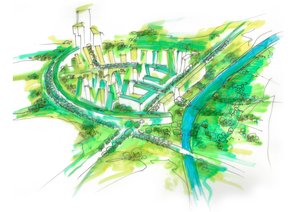 A step closer to the new Pod Žofinkou district
A step closer to the new Pod Žofinkou district
Ostrava has an unprecedented opportunity to create an entirely new district in the heart of the city. The vacant brownfield site known as Pod Žofinkou is set to be transformed into a new city quarter for 12 000 people, including a nature park, direct access to the riverbank, and a unique new urban boulevard creating a direct connection between Ostrava city centre and the Lower Vítkovice area. The boulevard will be one mile long, with a tram route linking Vítkovice with Smetanovo náměstí (near the Antonín Dvořák Theatre). The project has now entered its next phase: the City of Ostrava has signed a memorandum on cooperation with landowners, which will enable work to begin on integrating the Pod Žofinkou area with Lower Vítkovice and the Černá Louka (Black Meadow) district of the city centre. A series of design studies will be drawn up, coordinated by a specially formed working group consisting of the memorandum signatories.
The project will require changes to Ostrava’s zoning plan – a step already approved by the City Assembly in June. Supporting documentation for the necessary changes is currently being drawn up, and the costs will be borne by all the parties involved.
By the end of 2023 a planning contract will be drawn up, setting out details of the cooperation.
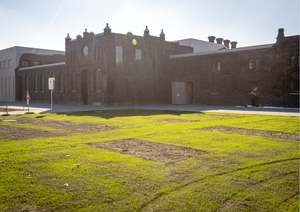 Public space in Ostrava is becoming more and more important
Public space in Ostrava is becoming more and more important
The quality of Ostrava’s public spaces often does not correspond with the importance of their location, and local residents are often dissatisfied with the appearance of their local streets, squares and parks. However, the City has already taken several steps to improve the situation, and these efforts are continuing. Citizens spend a lot of time outside, especially in the summer months. Recent studies have shown that quality of life increases in direct proportion to the greenery that surrounds us. This does not depend on age or wealth: well-designed and well-kept urban greenery is equally important for everybody. Likewise, planting new trees in busy streets helps to improve air quality and reduces smog. The City of Ostrava is determined to apply these principles in its new development projects, thus bringing overall improvements in quality of life.
The newly revitalized historic city slaughterhouse – now the home of the Plato contemporary art gallery – is surrounded by 9000 square metres of public space. This space has now been sensitively and intelligently transformed into the GARDEN OF TODAY. The garden applies the ethical and practical principles of permaculture, and includes newly planted shrubs, trees, flowers, other plants, and floral meadows – creating a unique oasis of greenery around the gallery.
The garden will bloom in the spring, but its full beauty will only become evident two years after the planting. When it does, it will be an exceptionally attractive urban oasis for citizens and visitors alike. Next to the gallery is a City-owned plot of land on Masná Street with an area of 1770 square metres, which will be ideal for a bold, creative project by a future investor keen to harness and contribute to the unique energy that this part of the city centre now possesses.
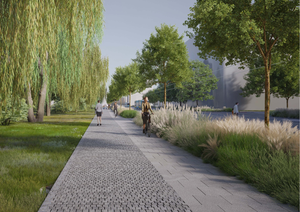 Another public space that will be ideal for a bold new improvement project is alongside the major urban transport artery of 28. ŘÍJNA STREET, in the vicinity of the City of Ostrava Cultural Centre. This section of the road runs for roughly 600 metres from the Petr Bezruč Theatre along the western boundary of the park (Sad Dr. Milady Horákové). It is set to be transformed with the planting of a wide band of greenery to separate cars and trams from the zone used by pedestrians and cyclists. A number of traffic light-controlled pedestrian crossings will be built along this section.
Another public space that will be ideal for a bold new improvement project is alongside the major urban transport artery of 28. ŘÍJNA STREET, in the vicinity of the City of Ostrava Cultural Centre. This section of the road runs for roughly 600 metres from the Petr Bezruč Theatre along the western boundary of the park (Sad Dr. Milady Horákové). It is set to be transformed with the planting of a wide band of greenery to separate cars and trams from the zone used by pedestrians and cyclists. A number of traffic light-controlled pedestrian crossings will be built along this section.
Why this location? It is the home of several important institutions, with more construction projects set to be implemented in upcoming years. However, the current state of this important boulevard does not match its importance. The revitalization project will form part of a group of major investments in the wider vicinity – including the reconstruction of the Náměstí Republiky intersection, the brand-new concert hall, and the new research library. The design phase of the project will begin next year, enabling the architects’ vision to be transformed into reality.
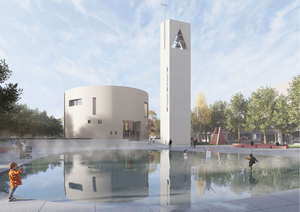 A new public space will be created around the CHURCH OF THE HOLY SPIRIT, offering an ideal place for local residents to meet and relax. The winner of the urban planning competition for the site (organized by MAPPA, the Municipal Studio for Urban Planning and Architecture) was the Brno-based studio M2AU. The centrepiece of the new public space will be a water feature (a lake), and the area will also feature rows of trees and an open area for events. Parking will be provided at the sides of the church. At the rear will be a space for an open-air cinema, a children’s playground and a parkour area. Strikingly designed street furniture will also be installed, taking its cue from the distinctive geometric shapes of the church’s windows.
A new public space will be created around the CHURCH OF THE HOLY SPIRIT, offering an ideal place for local residents to meet and relax. The winner of the urban planning competition for the site (organized by MAPPA, the Municipal Studio for Urban Planning and Architecture) was the Brno-based studio M2AU. The centrepiece of the new public space will be a water feature (a lake), and the area will also feature rows of trees and an open area for events. Parking will be provided at the sides of the church. At the rear will be a space for an open-air cinema, a children’s playground and a parkour area. Strikingly designed street furniture will also be installed, taking its cue from the distinctive geometric shapes of the church’s windows.
 The Hrušov district and its future
The Hrušov district and its future
Hrušov forms part of the Slezská Ostrava municipal district. It is located on the northern edge of Ostrava, just a 10-minute drive from the city centre, and it is also well served by public transport. In 1997 Hrušov suffered severe damage from catastrophic floods, marking the final blow for a district that was the childhood home of several popular personalities including the actor Vlastimil Brodský and the singer Marie Rottrová.
After the floods, most of Hrušov was abandoned and became a brownfield site. Recently, part of the brownfield was revitalized with the opening of the Contera logistics park, which takes advantage of the site’s excellent transport links and proximity to international markets (Poland and Slovakia). Thanks to Contera’s investment, new life has been breathed into the district – but it is essential to ensure that it continues to develop in the right direction.
The City’s Municipal Studio for Urban Planning and Architecture (MAPPA) was tasked with producing a study to explore the potential for developing the district to create a polyfunctional urban structure. The study will also serve as a supporting document for necessary changes to the zoning plan.
The completed study was presented to the public in November of this year by the architect Lukáš Grasse from the Gogolák+Grasse studio. The document covers an area in the western part of Hrušov, bounded by the Ostravice and Odra rivers, Bohumínská Street and the international railway corridor. It was historically the central part of Hrušov, and a number of valuable buildings have survived – including the neo-Gothic Church of St. Francis and Victor. Almost the entire area is currently zoned for large-scale light industrial units.
The key ideas at the heart of the study were very well received by members of the public. Everybody is aware of certain environmental issues in the area, and it will take some time before these are fully eliminated. However, the study proved that the future development of Hrušov is a genuinely viable proposition – including the preservation of some valuable existing features such as the school building, the church, the former Hubert coal mine, and others. It would be possible to create public access to the riverbank zones and to enable the construction of light industrial units as well as services and sports facilities. Hrušov also offers excellent conditions for parks and greenery, and it would be an ideal location for cycling infrastructure. Another interesting proposal was the possible use of the site for a science and technology park.
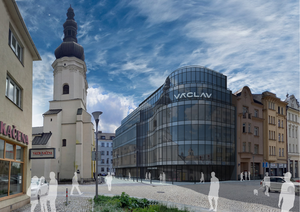 Another vacant lot in the city centre will be built on
Another vacant lot in the city centre will be built on
A new multifunctional development is set to be built at Kostelní náměstí in Ostrava city centre. To be known as Dům Václav (after the nearby Church of St. Wenceslas), the development will contain 16 apartments, 76 parking spaces, offices, and commercial units.
Preparatory work has now been launched at the site, including an archeological survey. Construction is scheduled to begin in 2024. The investor is the developer Antracit.
Vacant lots represent a huge source of potential for investors and developers. In most cities, the opportunity to build on a vacant lot in the city centre is a very rare scenario. However, Ostrava still offers some vacant lots at highly lucrative locations, which will potentially enable investors to raise their profile and create something truly exceptional – featuring high-quality architecture, new technologies, and beautifully designed public spaces. All of these are of key importance for the future development of the city.
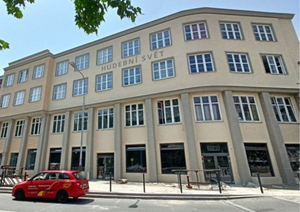 Owners of important buildings can again receive funding for renovation projects
Owners of important buildings can again receive funding for renovation projects
The City of Ostrava regularly subsidizes renovation and modernization projects at a range of privately-owned buildings, including residential blocks, industrial heritage sites and sacred buildings. The City’s subsidy programme has already helped to fund such projects at more than 200 important buildings throughout Ostrava. For example, the Hudební Svět music club in the “Little Copenhagen” city centre quarter has been able to revitalize its façades, as have the distinctive red-brick former workers’ cottages at the “Gable Colony” in Vítkovice – a popular location for film productions. Owners can apply for up to 1.5 million CZK to renovate important buildings in the city, and the owners of sacred buildings can apply for up to 500 000 CZK.
Applications can be submitted from 2 January 2023 up to 20 February 2023. For more information see http://1url.cz/trTKr.
Watch this short video presenting a range of things that have happened in Ostrava during 2022.



